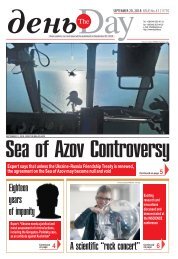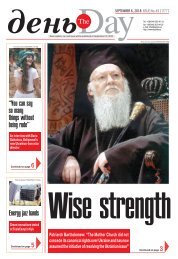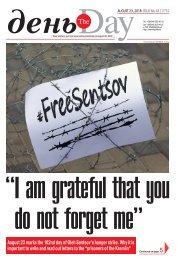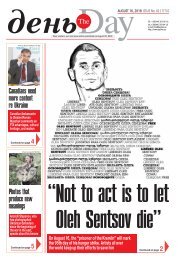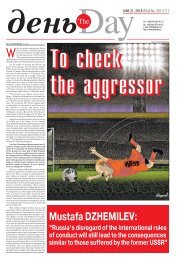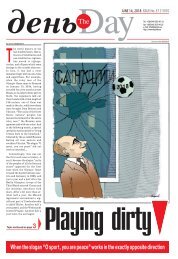You also want an ePaper? Increase the reach of your titles
YUMPU automatically turns print PDFs into web optimized ePapers that Google loves.
4<br />
No.48 SEPTEMBER 27, 2018<br />
TOPIC OF THE DAY<br />
WWW.DAY.KIEV.UA<br />
By Oleksii SAVYTSKYI<br />
Ukraine has placed second<br />
among the countries that<br />
achieved the greatest progress<br />
over the past four years<br />
in the field of information<br />
disclosure. Meanwhile, this country<br />
holds the 17th position overall out of<br />
the 30 countries that have joined the<br />
International Open Data Charter.<br />
Within Ukraine, Drohobych has been<br />
the leader in data disclosure this year.<br />
Recently, this 100,000-strong city won<br />
the national competition Open Data<br />
Awards 2018.<br />
Drohobych can offer the rest of<br />
the country a real master class in making<br />
routine and uninteresting bureaucratic<br />
documentation useful to the<br />
community as it creates new services<br />
and even makes money.<br />
Even as recently as two years ago,<br />
most decisions, reports, or routine statistics<br />
remained confined to the internal<br />
servers of the city council or even<br />
old paper journals. However, local officials<br />
then began to publish the entire<br />
information about the city’s life: from<br />
real estate registers to tender procedures<br />
and the number of patients admitted<br />
by the outpatient hospital. All<br />
these data are now made available to<br />
residents at the city’s website, which<br />
can be accessed from any Internet-capable<br />
gadget.<br />
“You can see a whole picture after<br />
just three or four clicks, whether it concerns<br />
finances, alliances, and conflicts<br />
involving local councilors, or decisions<br />
they make,” local civic activist, editorin-chief<br />
of the Media Drohobychchyny<br />
newspaper Mariia Kulchytska shared<br />
her impressions.<br />
According to her, the work of local<br />
journalists has become much simpler.<br />
After all, if earlier one had to submit<br />
dozens of requests to get some figure<br />
having to do with the city budget or tender<br />
procedures, now it is enough to go<br />
to the city’s website. Local authorities<br />
post all their decisions there of their<br />
own accord, without waiting for requests.<br />
And these are not just scanned<br />
bureaucratic documents, but also analyzed<br />
data.<br />
How open data improves Ukrainians’ lives<br />
A master class from Drohobych<br />
Photo by Ruslan KANIUKA, The Day<br />
A good example of turning dull statistics<br />
into useful services was shown in<br />
the case of the local outpatient hospital.<br />
The Drohobych hospital was among the<br />
first in Ukraine to open its registry data<br />
for citizens, enabling them to schedule<br />
a doctor’s appointment online. In just<br />
20 days of this September, over 9,000 citizens<br />
did so through the e-registry.<br />
“We save both patients’ and doctors’<br />
time. There are no queues at the doctor’s<br />
cabinet’s door anymore. Everything is<br />
scheduled hour by hour, everything is<br />
scheduled online,” acting chief doctor of<br />
the Drohobych City Outpatient Hospital<br />
Yuliia Honcharenko told us.<br />
Moreover, local patients have their<br />
own electronic medical records. People<br />
can access them, too, using their own<br />
smartphones, if need be, and doctors<br />
can do the same: a patient may well<br />
need urgent advice or be in some kind<br />
of emergency.<br />
“We had a case when a person had<br />
become unconscious, so the doctors<br />
saw in his electronic declaration that he<br />
had diabetes, and already knew how to<br />
proceed further, how to help him.”<br />
This kind of healthcare reform has<br />
also been of interest to residents of the<br />
district and neighboring towns. According<br />
to Drohobych officials, electronic<br />
innovations have attracted hundreds<br />
of so-called medical tourists to<br />
the city. People go to Drohobych to take<br />
advantage of the quick and convenient<br />
services offered by the city’s doctors.<br />
The city’s mayor is happy: this<br />
project has been a success not only in<br />
terms of reputation, but also economically.<br />
After all, more data makes for better<br />
analytics, and hence better decisions.<br />
The city’s money is spent wisely.<br />
“Now we can fund priority projects.<br />
For example, we did thermo-modernization<br />
of a kindergarten. We have<br />
been saving on heating bills due to it.<br />
Also, we have replaced the mains pipes,<br />
taps and have been saving on water<br />
bills. Such seeming trifles have a very<br />
big impact when it is done on a city<br />
scale, believe me,” asserted Taras Kuchma,<br />
the mayor of Drohobych.<br />
As a result, investors have grown<br />
more interested in Drohobych, and the<br />
city’s advertising revenues have doubled.<br />
While they stood at 176,000<br />
hryvnias in 2016, then in 2017 the figure<br />
was already 350,000 hryvnias.<br />
This was because the newly created<br />
service, based on open data, allowed the<br />
city to detect all illegal advertising<br />
boards, and the field work was done by<br />
citizens themselves.<br />
“You look at the address, go to the<br />
corresponding web service, look<br />
whether the board is registered, and if<br />
it is not, you submit a report to that effect<br />
and this illegal advertisement gets<br />
removed. Why is this important? Because<br />
it increases the local budget’s revenues,”<br />
Kulchytska said.<br />
Manager of the Drohobych Smart<br />
City program explained that the success<br />
came from data presentation. The website<br />
offers not just a set of dry figures<br />
filling endless spreadsheets, but readyfor-use<br />
analytics as well.<br />
“You wanted the information, and<br />
it is already here. We have 240 unique<br />
sets of data. But if we say to residents,<br />
‘here is an Excel spreadsheet,<br />
now look for yourselves,’ it will come<br />
to nothing. We have presented it in<br />
such a way that it is interesting to residents,”<br />
said Stanislav Haider, head of<br />
the department of information technology<br />
and analytics of the Drohobych<br />
City Council. “Four illegal billboards<br />
were found within a month after this<br />
project started, all thanks to our citizens.<br />
We have opened the data and visualized<br />
it for people.”<br />
It should be added that such a project<br />
of open data was cheap and paid for<br />
itself within its first year of operation.<br />
And now it brings increasing benefits<br />
every day. In particular, it helps the<br />
formation of civil society.<br />
“By default, data, just like the<br />
city’s budget, belong to its residents.<br />
And it is important for us that both the<br />
residents and the authorities understand<br />
it, that the residents act as citizens,<br />
not guests of their city,” Haider<br />
concluded.<br />
The next stage of the local Smart<br />
City program will involve the<br />
blockchain technology applied to municipal<br />
projects. For example, the queue<br />
for children’s entry to kindergarten will<br />
be monitored with the help of modern<br />
means in the educational sector. Should<br />
some official try to change some child’s<br />
place in the queue manually, the<br />
blockchain technology will record it. It<br />
is hoped that the new approach will minimize<br />
most corruption risks.<br />
By Olesia SHUTKEVYCH, The Day,<br />
Vinnytsia region<br />
Aunique Cossack-era wooden<br />
church has been rebuilt in<br />
the village of Mala Rostivka,<br />
Orativ raion. According to<br />
the extant data, the shrine<br />
was built back in 1776, restored in the<br />
1830s, and closed a century ago,<br />
sometime after 1917. The locals say,<br />
however, that the mass was still<br />
clandestinely celebrated in the church<br />
until 1943, and then the structure was<br />
used to house first a club, and later a<br />
collective farm storage facility. The<br />
neglect ultimately resulted in only<br />
wooden walls of the once majestic<br />
shrine still standing, which began to<br />
overgrow first with weeds, and then<br />
with trees.<br />
The local farmer Mykola Motuziuk<br />
and his oncologist son Ihor resolved<br />
to revive the shrine. At first,<br />
they were looking for and studying<br />
the documents about the church; they<br />
say that they had covered half of<br />
Ukraine while searching for a similar<br />
structure, but had not found one.<br />
Therefore, they resolved, with the<br />
support of historians, restorers, and<br />
the village community, to restore this<br />
shrine of the extraordinary architecture.<br />
The restoration lasted two years<br />
and has now entered its final stage.<br />
The church already hosts divine services<br />
on major feast days. The farmer<br />
refuses to reveal how much money he<br />
has spent on this unique building, saying<br />
only that money has no memory,<br />
while the preserved church will last<br />
for many years.<br />
“I came to Orativ raion in the<br />
1980s. Each time I visited Mala Rostivka,<br />
the destroyed church on the<br />
“If our ancestors built it, we have to preserve it”<br />
In Vinnytsia region, a local farmer has restored<br />
a Cossack-era church at his own expense,<br />
with only interior repairs still to be done<br />
hill unnerved me. The church was<br />
decaying, in fact rotting, and it<br />
pained me. The village mayor sent<br />
letters to the authorities, even went<br />
to the Exhibition of Achievements of<br />
National Economy in Kyiv requesting<br />
that they take away the church,<br />
but since the shrine was not a monument<br />
of architecture, nobody responded.<br />
Meanwhile, people (if they<br />
deserve to be called this name)<br />
ripped up the floor, since it was<br />
made of solid oak boards, and carried<br />
them to their farmsteads. Over the<br />
years, the shrine decayed until there<br />
were only ruins left...<br />
Photo courtesy of the author<br />
THE NEGLECT ULTIMATELY RESULTED IN ONLY WOODEN WALLS OF THE ONCE<br />
MAJESTIC SHRINE STILL STANDING, WHICH BEGAN TO OVERGROW FIRST<br />
WITH WEEDS, AND THEN WITH TREES. IT WAS THE LOCAL FARMER MYKOLA<br />
MOTUZIUK AND HIS SON IHOR WHO REVIVED THE SHRINE<br />
MYKOLA MOTUZIUK<br />
“My son and I sought data on the<br />
church and found that the construction<br />
of the Church of the Intercession<br />
in the village of Mala Rostivka was<br />
completed in 1776. It was built to a<br />
unique design, namely a wooden tetraconch<br />
with an attached bell tower.<br />
Such shrines were often built by the<br />
Cossacks, and therefore the village<br />
church is known as a Cossack one.<br />
When we took to farming, we first intended<br />
to demolish it and build a new<br />
shrine from scratch. However, we<br />
then realized that if our ancestors had<br />
built it, we had to preserve it. Having<br />
saved a little money, we began restoration<br />
work in the summer of 2016, just<br />
after the harvest ended.<br />
“There was no red tape to combat,<br />
because the church was not listed as a<br />
monument of architecture. Still, we<br />
could not do it without the help of experts.<br />
We had to know how reliable<br />
the beams were. An expert examination<br />
helped. The experts examined a<br />
piece of timber from the framework<br />
that we brought to them for testing,<br />
and found that timber making up the<br />
walls of the church was about<br />
300 years old. We then left some<br />
beams in place, but a lot of them had<br />
to be replaced.<br />
“We started by bringing there a<br />
few cranes, raising the building, putting<br />
it on logs, strengthening the<br />
foundation, putting oak weights in,<br />
laying wooden flooring so that the<br />
acoustics were good during divine<br />
services, and roofing the structure.<br />
All the walls were treated with antiseptic<br />
to keep insects out. We have restored<br />
the domes and erected a bell<br />
tower. Now the church is exactly like<br />
it once was. All that remains is to<br />
make an iconostasis and do landscaping<br />
work outside. We are in the final<br />
stage of our effort. A priest from the<br />
neighboring village of Chahiv celebrates<br />
the mass on feast days. People<br />
do attend, but there are not that many<br />
of them. The village is small, with<br />
150 to 200 residents only, but we see<br />
kids at every divine service, and we<br />
like it.”<br />
Mala Rostivka is located in the<br />
middle of nowhere, 20 kilometers<br />
from the raion center, so tourists are<br />
rare there. It is a pity, really, because<br />
apart from the Cossack church, the<br />
magnificent palace of General Zabotin<br />
is located in the village. It has been<br />
finely preserved to this day, even<br />
though it stands empty in the<br />
foothills.



